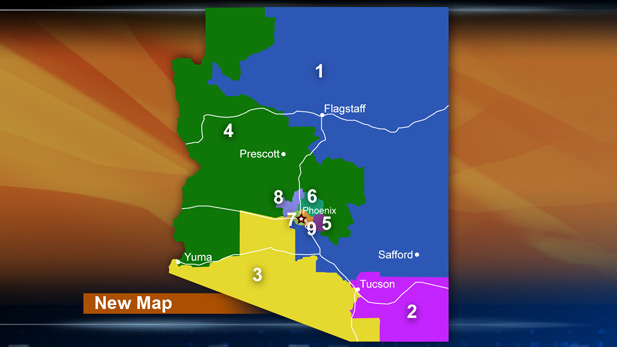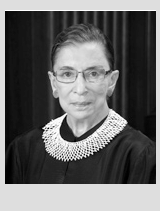 Arizona congressional districts, approved in 2012.
Arizona congressional districts, approved in 2012.
Listen:
The U.S. Supreme Court Monday upheld Arizona's independent system for redrawing congressional district boundaries.
The system, called the Arizona Independent Redistricting Commission, has been in place since voters approved it in 2000, taking direct authority for drawing the boundaries away from the Legislature.
The 5-4 decision means the lines as they were drawn in 2011 and used for the 2012 and 2014 congressional elections will remain for 2016 and beyond.The next redistricting will follow the 2020 U.S. census.
 U.S. Supreme Court Justice Ruth Bader Ginsburg.
U.S. Supreme Court Justice Ruth Bader Ginsburg." ... The Arizona Constitution 'establishes the electorate as a coordinate source of legislation' on equal footing with the representative legislative body," Justice Ruth Bader Ginsburg wrote in the majority opinion.
"The people of Arizona turned to the initiative to curb the practice of gerrymandering and, thereby, to ensure that members of Congress would have 'an habitual recollection of their dependence on the people',” the opinion said, quoting from founding father James Madison's Federalist Papers.
"In so acting, Arizona voters sought to restore 'the core principle of republican government,' namely, 'that the voters should choose their representatives, not the other way around'," the opinion said, again quoting Madison.
Ginsburg was joined in the majority by Justices Stephen Breyer, Elena Kagan, Anthony Kennedy and Sonia Sotomayor. Chief Justice John Roberts and Justices Samuel Alito, Antonin Scalia and Clarence Thomas dissented.
Roberts wrote the lead dissenting opinion.
 Chief Justice of the U.S. John Roberts.
Chief Justice of the U.S. John Roberts."The relevant question in this case is how to define 'the Legislature' under the Elections Clause," Roberts wrote, referring to the U.S. constitutional provision upon which the case was based. "The majority opinion does not seriously turn to that question until page 24, and even then it fails to provide a coherent answer."
Scalia and Thomas said in their dissents that Republican state legislators did not have "standing" to bring the case to the court, meaning their dissents were directed at that technicality and not at the issue of who has authority to draw district boundaries. Still, Scalia said it was his opinion that authority for redistricting rests with the Legislature and not the commission.
The definition of "legislature" was key to the case, with Republicans arguing that the U.S. Constitution is clear that elected representatives would have the power. Democrats argued that Proposition 106, which amended the state Constitution and created the independent process, allowed voters to assign redistricting as they saw fit.
Republican dominance of Arizona politics could have been strengthened if the court had ruled in favor of the Republican legislators who sued the commission. They were poised to open a special session to redraw the lines had the court ruling gone their way.
Senate President Andy Biggs, R-Gilbert, and House Speaker David Gowan, R-Sierra Vista, who were parties to the lawsuit, released a statement criticizing the ruling.
"We are disappointed that the Supreme Court has decided to depart from the clear language of the Constitution," Biggs and Gowan said in the statement. "The framers selected the elected representatives of the people to conduct congressional redistricting. It's unfortunate that the clear constitutional design has been demolished in Arizona by five lawyers at the high court."
A Republican redrawing of boundaries could have helped U.S. Rep. Martha McSally, R-Ariz., in her 2nd Congressional District, covering Tucson's east side and all of Cochise County. Its electorate is split almost evenly among registered Republicans, Democrats and independents.
McSally lost the 2012 election by 2,400 votes to Democrat Ron Barber. In 2014, the outcome was reversed, with McSally winning the congressional seat by 167 votes after a recount. McSally issued a statement shortly after the court's ruling was announced.
“I respect the court’s decision today, and look forward to continuing to represent the people of Arizona’s 2nd District," she said in the statement. "I was sent to Congress with a job to do, and will continue to work tirelessly with the focus of expanding economic opportunity and improving security for Southern Arizonans.”
Tucson Democratic state Rep. Victoria Steele, who has said she is exploring a run for the 2nd Congressional District seat in 2016, issued a statement lauding the court's decision.
"I am encouraged to learn of this ruling in favor of the power of the people in Arizona," Steele's statement said. "We can now get on with the important business of electing our next congressional delegation."
At issue was the state constitutional amendment that voters passed as Proposition 106. It created the Arizona Independent Redistricting Commission, taking away the Legislature's direct involvement in redrawing congressional boundaries every 10 years.
Republicans in the Legislature claimed the amendment usurped lawmakers' authority to make election-related decisions, as stated in Article 1, Section 4 of the U.S. Constitution.
Paul Bender, a professor at Arizona State University's Sandra Day O'Connor College of Law, said the Supreme Court justices in the minority on the case missed the point.
"It seemed to me the argument that they did not fully understand is that in Arizona, the people are the legislature," Bender said. "So when the Constitution says the legislature of the state shall do the redistricting, they're saying the people can decide how to do it."
Currently, four of Arizona's congressional districts have heavy majorities of registered Republican voters, two have heavy majorities of registered Democratic voters, and three are considered competitive, with roughly even numbers of registered Republicans, Democrats and independents.
The independent commission drew boundaries after the 2000 census and again after the 2010 census. In 2012, five Democrats and four Republicans were elected to Congress in Arizona. In 2014, five Republicans and four Democrats were elected.
The commission has five members, with the state Senate president, the state House speaker, the Senate's minority leader and the House's minority leader each choosing one from a list submitted by a judicial review panel. The four politically selected commissioners select a fifth, independent voter to be the commission's chair.
The court case decided Monday was called Arizona State Legislature v. Arizona Independent Redistricting Commission.



By submitting your comments, you hereby give AZPM the right to post your comments and potentially use them in any other form of media operated by this institution.